高中英语人教版新课标必修5Unit 4 Grammar:倒装句
- 格式:doc
- 大小:69.50 KB
- 文档页数:4

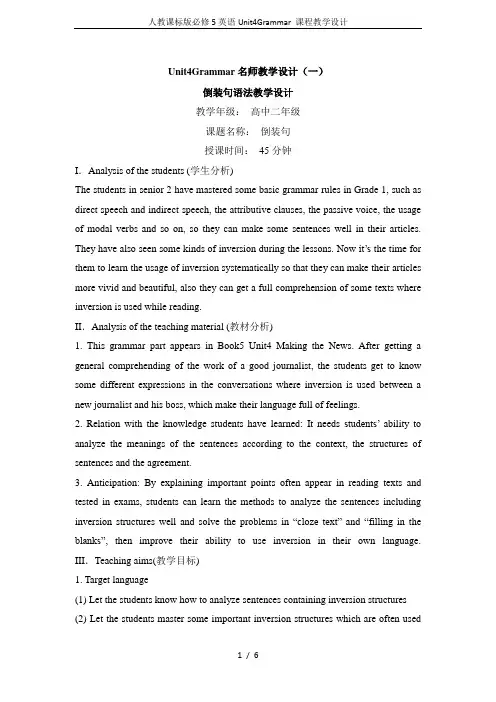
Unit4Grammar名师教学设计(一)倒装句语法教学设计教学年级:高中二年级课题名称:倒装句授课时间:45分钟I.Analysis of the students (学生分析)The students in senior 2 have mastered some basic grammar rules in Grade 1, such as direct speech and indirect speech, the attributive clauses, the passive voice, the usage of modal verbs and so on, so they can make some sentences well in their articles. They have also seen some kinds of inversion during the lessons. Now it’s the time for them to learn the usage of inversion systematically so that they can make their articles more vivid and beautiful, also they can get a full comprehension of some texts where inversion is used while reading.II.Analysis of the teaching material (教材分析)1. This grammar part appears in Book5 Unit4 Making the News. After getting a general comprehending of the work of a good journalist, the students get to know some different expressions in the conversations where inversion is used between a new journalist and his boss, which make their language full of feelings.2. Relation with the knowledge students have learned: It needs students’ability to analyze the meanings of the sentences according to the context, the structures of sentences and the agreement.3. Anticipation: By explaining important points often appear in reading texts and tested in exams, students can learn the methods to analyze the sentences including inversion structures well and solve the problems in “cloze text”and “filling in the blanks”,then improve their ability to use inversion in their own language. III.Teaching aims(教学目标)1. Target language(1) Let the students know how to analyze sentences containing inversion structures(2) Let the students master some important inversion structures which are often usedin sentences: Only after ... did sb. ... Only by doing ... could sb. ... Not only did ... Seldom have I ...2. Ability goalsEnable the students to use inverted sentences correctly Guide the students to summarize the usage of Inversion3. Learning strategiesAsk the students mark out the sentences using inversion when reading or doing exercises, analyzing the structures and try to work out the meanings. And try to use this structure in their own articles and language.4. Affection and attitudesEnable the students to be careful and patient when analyzing inversion structures, considering the basic sentence pattern and the agreement.IV.Teaching strategies(教学策略)1. Teaching methods(1). Let the students find the sentences of Inversion in the reading passageand understand the meaning of them and conclude the two types of inversion (2). Explain important points often appear in reading texts or exams to help them know the rules.(3). Give the students some sentences or short passages to let them understand the rules better.(4). Task-based learning; cooperative learning; practice2. Teaching aidsA computer and a projector, related materials (self assessment)一、创设情景导入新课Your childhood story :Long long ago, there was a hill; on the hill stood a temple(寺庙), in the temple lived an old monk(和尚), the old monk was telling stories to a little monk…1. What grammar can you find out?__________________________________________________________2. The definition__________________________________________________________3. Two types二、自主学习归纳总结全部倒装:1. Here comes the bus2. Now come the men’s 110 hurdles.3. There goes the bell.总结:___________________________________________________________1. Out rushed the puppy.2. Down jumped the man from the horse.3. Away went the girl.总结:___________________________________________________________1. From the valley came a frightening sound.2. Under the tree stands a little boy.总结:___________________________________________________________ There are many students in the classroom.总结:___________________________________________________________ 部分倒装:1. Hardly(Scarcely) had he reached the station when the train started..2. Never shall I do this again.3. Seldom in all my life have I met such a determined person.4. Not until the teacher came did he finish his homework总结:1. Only after three operations was she able to walk without sticks.2. Only then did we realize that the man was blind.3. Only by seizing every minute can we finish it on time.4. Only a few young men went to the theatre.总结:注意:(第四句)So loudly did he speak that even people in the next room could hear him.总结:1. Young as he is, he knows more than you.2. Hard as he worked, he made little progress.3. Try as he would, he couldn’t lift the stone.4. Child as he is, he can answer this question.总结:as引导让步状语时,_____________________________________________1. Were he younger, he would learn skating.2. Should they forget to bring a map with them, they would get lost in the woods.3. Had they realized how important the task was, they wouldn’t have refused it.总结:省略if的条件句,提前were/should/had.三、课堂练习巩固提升写作运用:运用倒装句。
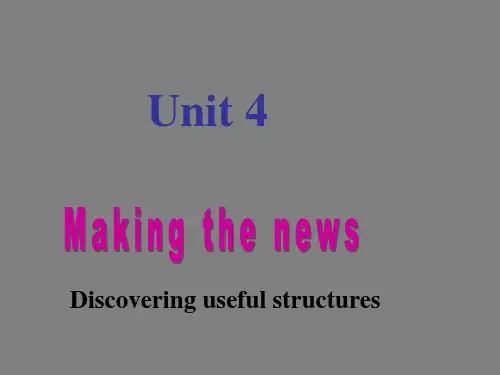
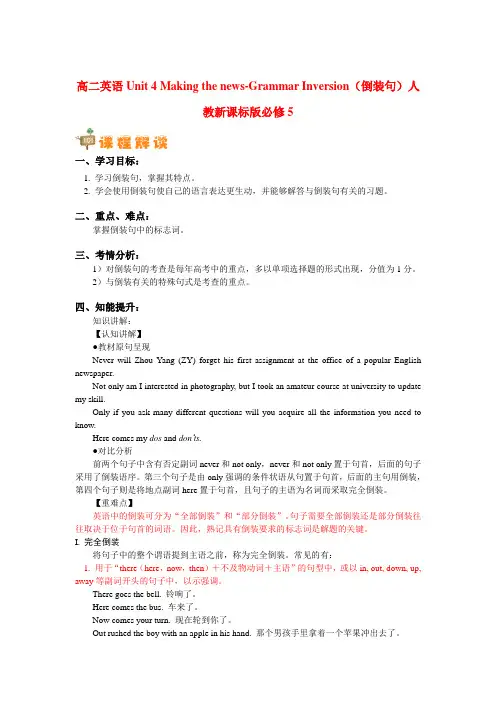
高二英语Unit 4 Making the news-Grammar Inversion(倒装句)人教新课标版必修5一、学习目标:1. 学习倒装句,掌握其特点。
2. 学会使用倒装句使自己的语言表达更生动,并能够解答与倒装句有关的习题。
二、重点、难点:掌握倒装句中的标志词。
三、考情分析:1)对倒装句的考查是每年高考中的重点,多以单项选择题的形式出现,分值为1分。
2)与倒装有关的特殊句式是考查的重点。
四、知能提升:知识讲解:【认知讲解】●教材原句呈现Never will Zhou Yang (ZY) forget his first assignment at the office of a popular English newspaper.Not only am I interested in photography, but I took an amateur course at university to update my skill.Only if you ask many different questions will you acquire all the information you need to know.Here comes my dos and don’ts.●对比分析前两个句子中含有否定副词never和not only,never和not only置于句首,后面的句子采用了倒装语序。
第三个句子是由only强调的条件状语从句置于句首,后面的主句用倒装,第四个句子则是将地点副词here置于句首,且句子的主语为名词而采取完全倒装。
【重难点】英语中的倒装可分为“全部倒装”和“部分倒装”。
句子需要全部倒装还是部分倒装往往取决于位于句首的词语。
因此,熟记具有倒装要求的标志词是解题的关键。
I. 完全倒装将句子中的整个谓语提到主语之前,称为完全倒装。
常见的有:1. 用于“there(here,now,then)+不及物动词+主语”的句型中,或以in, out, down, up, away等副词开头的句子中,以示强调。
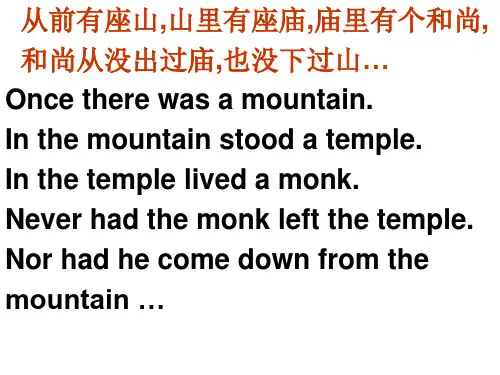
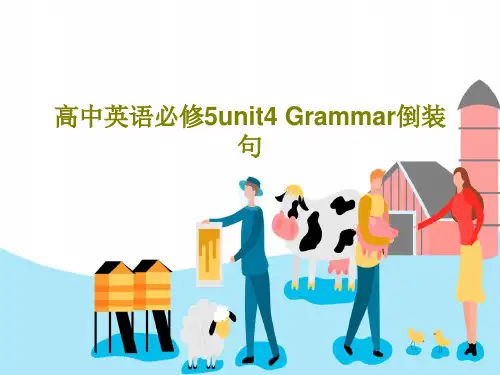
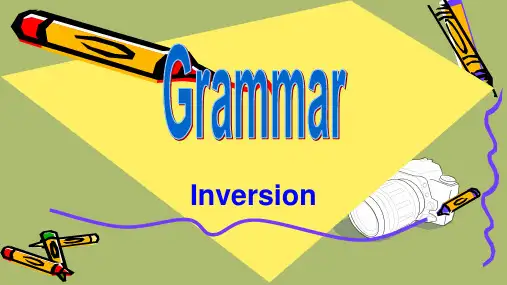
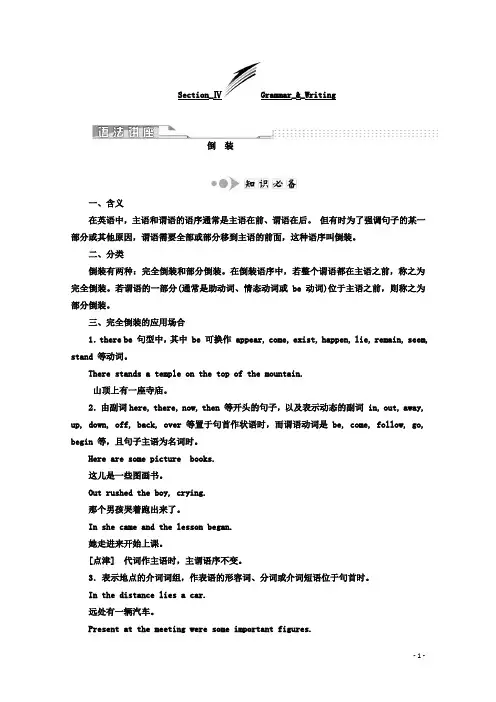
Section_ⅣGrammar_&_Writing倒装一、含义在英语中,主语和谓语的语序通常是主语在前、谓语在后。
但有时为了强调句子的某一部分或其他原因,谓语需要全部或部分移到主语的前面,这种语序叫倒装。
二、分类倒装有两种:完全倒装和部分倒装。
在倒装语序中,若整个谓语都在主语之前,称之为完全倒装。
若谓语的一部分(通常是助动词、情态动词或 be 动词)位于主语之前,则称之为部分倒装。
三、完全倒装的应用场合1.there be 句型中,其中 be 可换作 appear, come, exist, happen, lie, remain, seem, stand 等动词。
There stands a temple on the top of the mountain.山顶上有一座寺庙。
2.由副词here, there, now, then 等开头的句子,以及表示动态的副词 in, out, away, up, down, off, back, over 等置于句首作状语时,而谓语动词是 be, come, follow, go, begin 等,且句子主语为名词时。
Here are some picture books.这儿是一些图画书。
Out rushed the boy, crying.那个男孩哭着跑出来了。
In she came and the lesson began.她走进来开始上课。
[点津] 代词作主语时,主谓语序不变。
3.表示地点的介词词组,作表语的形容词、分词或介词短语位于句首时。
In the distance lies a car.远处有一辆汽车。
Present at the meeting were some important figures.出席会议的是一些重要人物。
Sitting in front of the house was a little girl.一个小女孩坐在房子的前面。
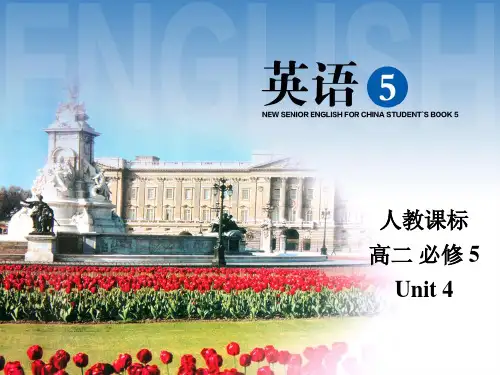
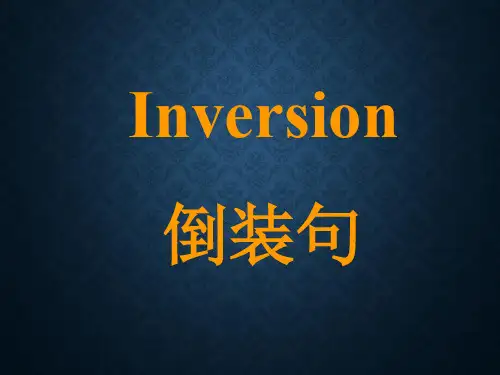
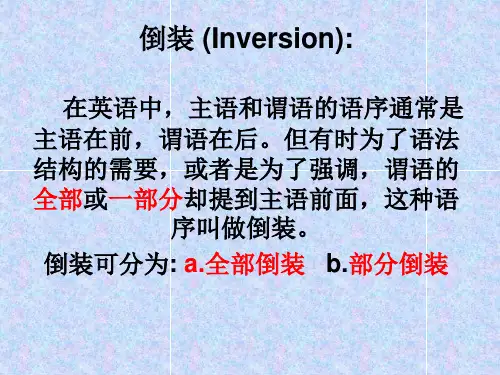
Unit4 单元语法详解图解语法倒装在英语中,主语和谓语的语序通常是主语在前,谓语在后,即正常语序。
但有时为了语法结构的需要或表示强调,就要采取倒装形式。
倒装可分为完全倒装和部分倒装两种。
一、完全倒装:指的是整个谓语提到主语前面主要有以下几种情况:1.There lie(s)/exist(s)/stand(s)/live(s)/come(s)+主语+其他,是There be句型的变体。
There is a tall building on the top of the mountain.山顶上有一幢高楼。
There stands a temple on the top of the mountain.i顶上有一座庙。
2.表示方向和地点的副词(here,there,up,down,in,out等)或介词短语位于句首,且主语是名词。
There goes the bell.铃声响了。
Here comes the bus.公交车来了。
From the valley came a cry.山谷里传来一声叫喊。
In front of the house stood a tower.房子前面立着一座塔。
3.“表语+系动词+主语”结构。
Present at the party were Mr.Green and many other guests.出席宴会的有格林先生,还有很多其他宾客。
Seated on the ground are a group of young men.坐在地上的是一群年轻人。
4.某些表示祝愿的句子。
Long live China!中国万岁!二、部分倒装:指的是将情态动词、助动词、be动词提到主语前主要有以下几种情况:1.“only+状语(从句)”放在句首时。
“only+状语”位于句首时,句子用部分倒装;“only+状语从句”位于句首时,主句用部分倒装,从句不倒装。
Only in this way can you learn English well.你只有用这种方法才能学好英语。
高中英语语法---倒装句讲解主备人:林佳翠一. 倒装的含义在英语中,主语和谓语的语序通常是主语在前,谓语在后。
但有时为了强调句子的某一部分或其他原因,谓语需要全部或部分移到主语的前面,这种语序叫倒装三. 全部倒装全部倒装是只将句子中的谓语动词全部置于主语之前。
此结构通常只用于一般现在时和一般过去时。
常见的结构有:1)here, there, now, then, thus等副词置于句首, 谓语动词常用be, come, go, lie, run等表示来去或状态的动词。
例如:Then came the chairman. 那时总裁来了。
Here is your letter. 你的信。
Here comes the car 车来了2)表示运动方向的副词(如in, out, up, down, away, off, back等)作状语置于句首。
例如:Out rushed the students 学生们冲了出来Ahead sat an old woman. 前面坐着一个老人。
注意:上述全部倒装的句型结构的主语必须是名词,如果主语是人称代词则不能完全倒装。
例如:Here he comes. 他来了。
Away they went. 他们走开了。
3)表示地点的介词短语置于句首或强调地点概念时,此时主句的动词常为be, sit, live, lie, stand, rise, go, come 等。
例如:Between the two buildings stands a tall tree.On the ground lay a sick goat.4) 为强调表语,把表语置于句首时,或为保持句子平衡时。
例如:Gone are the days when women were looked down upon. Present at the meeting was Mr Liu, who taught us English.5) 表示祝愿的句子。
高中英语学习材料madeofjingetiejiGRAMMAR倒装【归纳】英语中,有时出于句子结构的需要或为了强调某一句子成分,通常把谓语或谓语的一部分放在主语之前,称为倒装。
倒装分为完全倒装和部分倒装。
一、完全倒装完全倒装通常是把句子的谓语全部置于主语之前。
常见的完全倒装的情况有:1. 表示地点的介词短语位于句首且主语为名词而谓语为不及物动词时。
如:From the window came the beautiful sound of music.On the table stood two glasses and an empty bottle.2. out, in, up, down, off, here, there, now, then等副词位于句首且主语为名词时。
如:Down fell half a dozen apples.Here comes the bus.注意:主语为人称代词时,主语和谓语的语序不变。
如:Here she comes!3. 在there be结构中。
如:There is a man at the door who wants to see you.4. 作表语的形容词、过去分词等位于句首且主语为名词时。
如:Present at the meeting were Professor Smith, Professor Brown, Sir Hugh and many other famous people.Gone are the days when they could do what they liked to the people in the country.二、部分倒装部分倒装通常是把谓语的一部分(如助动词或情态动词)提到主语之前。
常见的部分倒装的情况有:1. 含有否定意义的副词或连词hardly, never, not, little, seldom, no longer, not only, not until等位于句首时。
InversionShe is a kind person 英语句子的语序英语句子的自然语序:英语句子的倒装结构:主语在前,谓语动词在后谓语动词放在主语之前自然语序Is she a kind person? 倒装语序倒装语序分为“全部倒装”和“部分倒装”。
在全部倒装的句子中,整个谓语都放在主语的前面;在部分倒装的句子中,只是谓语中的一部分(如助动词、情态动词或系动词be等)放在主语前面,其余部分仍放在主语后面。
下面将常见的全部倒装情况分述如下:1、here, there, now, then, thus等副词置于句首, 谓语动词常用be, come, go, lie, run等表示来去或状态的动词。
例如:There comes the bus!Now comes your turn.2. 表示运动方向的副词或地点状语置于句首,谓语表示运动的动词。
例如:Out rushed a missile from under the bomber. 轰炸机肚底下窜出一枚导弹。
Ahead sat an old woman. 前面坐着一个老妪。
3. 在there be或者there live(stand, appear, seem, remain, exist….) 句型中。
例如:There are thousands of people on the square.There lived an old fisherman in the village.There stands a little girl.4.在某些表示祝愿的句型中。
例如:Long live the People's Republic of China! 中华人民共和国万岁!May you all be happy. 愿你们都快乐。
5.某些表语位于句首,保持句子平衡,以强调表语. 句式:表语+系动词+主语(必须是名词) 1)表语为介词短语Among the goods are Christmas trees, flowers, candle s and toys. 2)表语为形容词 Present at the meeting were Mr White and many oth er guests. 3)表语为过去分词 Seated on the ground are a group of young people. 4)表语为进行时态中的现在分词 Lying on the floor was a boy. Standing beside the desk was a teacher.5)Such 作表语Such was Albert Einstein, a simple man of great achievements.Such is life.注意:上述全部倒装的句型结构的主语必须是名词,如果主语是人称代词则不能完全倒装。
Unit 4 Grammar:倒装句Ⅰ.回归课本(26页)1) Never_______ Zhou yang forget his first assignment at the office of a popular English newspaper.2) Not only_______ I interested in photography, but I took an amateur course at university to update my skills.3)Only if you ask many different questions ________ you acquire all the information you need to know.4)Here ______ my list of dos and don’ts.Ⅱ. 概念把______________放在主语之前,叫倒装结构。
如果__________放在主语之前, 叫全部倒装; 如果只把_________________等放在主语之前,叫部分倒装。
Ⅲ. 语法归纳(结合课本89页语法)巧记倒装(一)这里那里、这时那时、上来下去、出来进去、两离开。
(二)强调表语和状语。
(三)否定副、连放句首。
(四) so, nor, neither, 也如此。
(五) as (though), 引导让步句。
(六) only 修状位句首切牢记。
一、完全(全部)倒装【指把句子的全部谓语放在主语前】1.there be句型中, 其中be可换做appear/enter/come/exist/happen/lie/remain/stand/seem等动词。
There stands a temple on the top of the mountain. 山顶上有一座寺庙。
2.以地点副词here/there,时间副词now/then及方位副词out, in, up, down, away,off 等开头,且谓语动词多为be/come/go,常使用完全倒装以示强调。
【这些副词可巧记为:这里那里(here/there)、这时那时(now/then)、上来下去(up/down)、出来进去(out/in)两离开(away/off)。
】Here comes the bus.汽车来了Now comes our turn. 现在轮到我们了Out went the children.孩子们出去了There goes the bell.铃响了【注意】若主语是人称代词时,主谓不倒装。
Away it went.它走了Here you are.给你Down they flew.它们飞了下来3.表地点的介词短语或表方位的副词短语位于____,且谓语动词是be/come/go/lie/sit、stand/run/walk等不及物动词时,常用完全倒装。
【为了保持句子的平衡或为了强调表语和状语,或使上下文紧密衔接,把它们放在句首,用完全倒装。
(该结构不需加助动词。
)】East of the town lies a beautiful lake. Present at the meeting were all teachers.In a lecture hall of a university in England sits a professor.Outside the doctor’s clinic were twenty patients. West of the lake are two villages.二、部分倒装【指把句子的部分谓语(be动词/助动词/情态动词)放在主语前】1.含有否定意义的副词或词组,如hardly (scarcely), never, not, not only, not until,little, seldom,rarely,in no way(决不能)等放_____作状语时,或在no sooner…than…和hardly…when…句型中,no sooner和hardly放_______时句子要部分倒装。
(1)Hardly (Scarcely) ____ he reached the station when the train started.(2)Not once did we visit the city of our own.(3)Seldom in all my life _________ I met such a determined person.(4)Not only _______there no electricity, but also no water.(5)Not until he shouted at the top of his voice __________ she turn her head.(6)In no way can they leave here.他们决不能离开这儿。
2.______ 或________放在句首,表示前面说话的情况也适用于另一个人(物),即“也(也不),如此”,用倒装句。
【谨记:“so+助动词/连系动词/情态动词+主语”表示“...也一样”,“neither/nor+助动词/连系动词/情态动词+主语”表示“...也不”】(1) She is busy doing her homework.. So ____ her brother.(2) You passed the exam. So _________I.(3)He doesn’t like shopping. Neither _________ I.(4) He can’t speak any foreign language. Nor__________his father.3.由___________引导的让步状语从句中,其基本句式为:"形容词/副词/名词+as+主语+谓语"或"动词原形+as+主语+情态动词/助动词"。
(1) Child as he is, he knows a lot of English.(2)_______ _______ ______ ________ (虽然他们年老), they stuck to working.(3)_______ _______ ______ ________, (虽然他努力尝试)he couldn't lift the stone.(4)Try as I might, I couldn't lift the stone.4.________所修饰的副词、介词短语或状语从句放在句首,用倒装句。
(1)Only after three operations was she able to walk without sticks.(2)Only then __________we realize that the man was blind.(3)Only by seizing every minute __________we finish it on time.【注意】1)当Only修饰主语位于居首时,句子不用倒装。
Only the teachers are allowed to borrow books from the school library.只有老师才被允许从学校图书馆借书。
Only she can solve the problem. 只有她能解决这个问题。
2)当Only修饰状语从句时,从句不倒装,主句倒装。
Only when he came back did I know the truth.直到他回来时,我才知道了真相。
5. 在so / such …that 的结构中,若so/such 置于句首,则句子部分倒装.1) It is such an interesting book that John has read it twice.=Such an interesting book ______ ________that John has read it twice.2) My brother is such a clever boy that he can work out some problems that I can’t.=Such __ ____ ___ __ ___ ______ that he can work out some problems that I can’t.3) It is so interesting a book that John has read it twice.=So interesting a book _______ ________ that John has read it twice.4) He run So fast that nobody could catch up with him.= So fast ____ ____ ____ that nobody could catch up with him.6. 在省略了if 的虚拟条件句中,将were,had或should移到主语前构成部分倒装。
1)If you had reviewed your lessons, you might have passed the examination=Had you reviewed your lessons, you might have passed the examination.2)If you should need more information, please let me know.= _________________________________, please let me know.3)If I were you,I would do the work.= _____________, I would do the work.Ⅳ.Practice(挑战自我)1、请填写正确的助动词(be, have, had,do ,did, will)1 Never ___________ I forget the hospitality of the family in Tibet.2 Not until she spoke __________I realize she was a foreigner.3 Only then___________ we realize that the man was blind.4 Seldom in my life ___________ I met so determined a person.5 Noon sooner ___________I left my house than it began to rain.6 Not only ___________he read the book, but also remembered what he read.7 Never ___________ I been there.8 Only then __________I begin my work on designing a bridge.9 Not only ________ I interested in photography, but I took an amateur course.10 Below____________ a restaurant.2.把下列句子改为倒装。